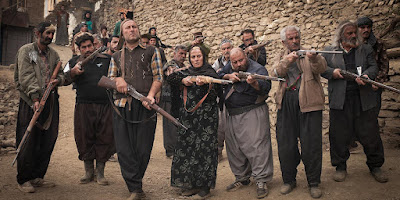Arsalan Amiri, Zalava (Iran, 2021)
Zalava is a small farming village. Nearby is a military outpost. The year is 1978, before the revolution in Iran. All is not well in Zalava.
The film opens with a woman hauling a large pack. She walks down cramped village paths. She comes across something. She stops dead in her tracks. She stares ahead with palpable fear. Her nose starts to bleed. Villagers arrive at the military outpost screaming there is a demon in the village. “She’s possessed!” Villagers surround her. Her fear grows. The villagers fear grows. She backs away from the mob and falls down a cliff to her death.
After this tragic death a complaint is filed towards the Sergeant of the outpost, Sergeant Massoud. (Navid Pourfaraj) He is blamed for the death of the woman because he ordered all the guns in the village to be confiscated. A young soldier Younes reads the military order that Sergeant will be effectively relieved of duty by the next morning.
As the villagers line up to receive their confiscated guns one of the people is Khalaj Zalavaei the father of the woman who fell to her death. Upon receiving his rifle he points the gun at Sergeant Massoud and pulls the trigger. The rifle, empty of bullets clicks. The Sergeant’s last night in command will be a long one. A black cat ominously wanders the military post.
The village is once again gripped in throes of fear. Another demon is attacking the village. Massoud and Younes take a jeep and drive up the windy, mountain roads to the village. A couple of dead, mutilated sheep lay on the side of the road. As they arrive villagers are in full panic mode trying to escape and save their livestock.
Way back in November 2016 here in America, people, mostly white people, began to wear safety pins as an act of solidarity with visible minorities who were rightfully concerned for their well being as a populist was elected riding a wave of nationalism and xenophobia to the White House. The underlying thought was that a person who was being threatened, say on a city bus, would spot the white person wearing a safety pin and approach knowing that they were with a “safe” person. Needlessly to say, placing the burden on the person who was already in a dangerous situation. In Zalava we also see safety pins being worn by the villagers. The thought is the demons are repelled by metal. Further, to this end we also see many scythes hanging from doorways.
A traveling exorcist by the name of Amardan (Pouria Rahimi Sam) - a true highlight of the movie – shows up to assist the village in the removal of the current demon. Amardan removes his shoes and heads up the stone steps to the house with the possessed person armed only with an empty glass pickle jar. If he is successful he will return with the demon successfully trapped inside the jar. If he does not succeed he has given firm instructions that he is to be stabbed below the waist to effectively bleed the demon out which will still keep the village safe.
Another character that should be mentioned is Doctor Maliheh. (Hoda Zeinolabedin) She works in the village collecting samples of the villager’s blood and urine to send to a government lab to ensure the villagers overall health but because of the level of anxiety in the village the samples contain far too much adrenaline and are not effective as true samples. Sergeant Mossoud is also quite smitten with her. Another matter to note is although Dr. Maliheh is very much rooted in science and medicine she does still believe that there is a possibility that demons do exist.
The film is ultimately the test of two wills. Khalija the influential villager who lost his daughter to the demon who wholeheartedly believes in the supernatural influences surrounding Zalava and the will of Massoud who believes that all the demon fears are nothing more than superstition. Interestingly, Aramand may believe or may only be riding the wave of paranoia to cash in. As was mentioned earlier Dr. Maliheh is a person of science and still retains some belief that the demons could be real.
There are some wonderful standout scenes with Dr. Maliheh and Sergeant Massoud as well as Massoud and Amaradan debating if he is actually an exorcist or just a con artist. There is also some horror troupes of a black cat, creaky doors and shadows on the wall. One of the best scenes involves the black cat and the pickle jar.
I consider this one of the best films I have seen this the 2021 edition of the Toronto International Film Festival because as a demonic possession, exorcist film it is playing off the genre convention that the audience will dismiss the reality of the demon until the big third act fantastical reveal of the demon. We didn’t believe, but we knew it all along. Zalava wonderfully subverts expectations. The demons of fear and superstition were visible the entire time. We are watching a community give into fear and superstition.
For me one of the great scenes of the movie is when the mob riding on delirious fear begin arguing amongst themselves on how they should proceed, contradicting the many long held steps to demon exorcism and removal. One other thing I want to mention, is the entry point into the story is definitely through horror conventions however the film is also very much a love story.
The film takes place in a per-revolutionary Iran but parallels a lot of what I am seeing in the world right now with an invisible virus. People are eschewing science and medical fact to chase disbelief and unproven medical cures. Of which the end result is many times, very scary, tragic and deadly results.




No comments:
Post a Comment